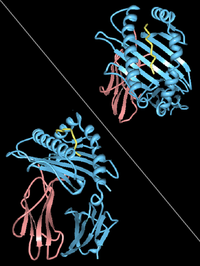
Photo from wikipedia
Objectives To clarify the association between HLA-DRB1 and TNFα (−308G>A) genes polymorphism and joint destruction/further progression during 12 months of the follow-up period (FUP) in patients with early ( Click to show full abstract
Objectives To clarify the association between HLA-DRB1 and TNFα (−308G>A) genes polymorphism and joint destruction/further progression during 12 months of the follow-up period (FUP) in patients with early (<6 months), active, predominantly ACPA and RF-positive RA treated according to ”Treat to target” strategy. Methods The study included 85 patients with early RA and duration of symptoms<6 months. RA diagnosis was established according to ACR/EULAR 2010 criteria. All patients were initially assigned to subcutaneous methotrexate (MTX) with rapid dose escalation to 20–25 mg/week. Combination MTX+biological therapy, mainly adalimumab, was used when MTX was ineffective. Joint destruction was assessed by Sharp-Van der Heijde modification scoring method at baseline and after 12 months FUP. Real time polymerase chain reaction (PCR-RT) was used for TNFα gene polymorphism (−308G>A) genotyping. Low resolution PCR-RT with subsequent sequence-based typing of *04 were performed to study HLA-DRB1 gene polymorphism. The HLA-DRB1*01, *04:01, *04:04, *04:05, *04:08, *10 alleles were categorised as SE+ (Shared Epitope) alleles. Results It was revealed that the number of erosions and joint space narrowings as well as the total Sharpe score were not associated with the presence and the dose of the SE alleles, either at baseline or after 12 months FUP. However, the progression of joint destruction, assessed as the change (Δ) in the number of erosions, joint space narrowings and the total score, was statistically significantly associated with HLA-DRB1*(SE) genotypes: the carriers of SE (SE+/SE+) double-dose had more advanced progression as compared to (SE+/SE-)/(SE-/SE-) carriers (p<0,028, p<0,019, p<0,035, respectively). As for TNFα gene polymorphism, it was demonstrated that the number of narrowings and total Sharp score values were almost twice as high at baseline in GG genotype carriers as compared to GA genotype carriers (69,049,5; 98,0 and 37,029,0; 63,0 respectively, p<0,005) and (72,049,5; 98,5 and 37,0,29,0; 63,0 respectively, p<0,004). Similar association was found after 12mo FUP, however, it should be mentioned that further progression of joint space narrowing and total Sharpe score was minimal (p>0,05). Conclusions Our data suggest that HLA-DRB1 (SE+) gene polymorphism is associated with the progression of radiographic joint destruction at 12mo FUP in treated pts. Meanwhile TNFα (−308G>A) polymorphism is associated with more pronounced joint destruction at baseline in terms of joint space narrowing and total Sharp score, but without further progression of joint destruction at 12mo in early and active RA pts managed according to ”Treat to target” strategy. Disclosure of Interest None declared
Journal Title: Annals of the Rheumatic Diseases
Year Published: 2018
Link to full text (if available)
Share on Social Media: Sign Up to like & get
recommendations!